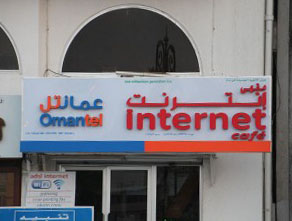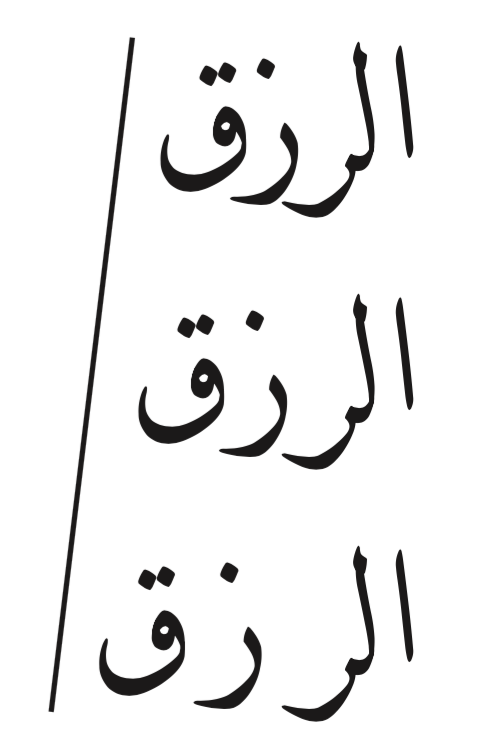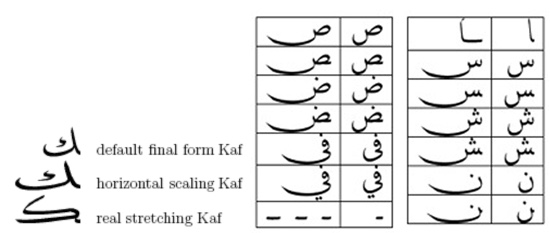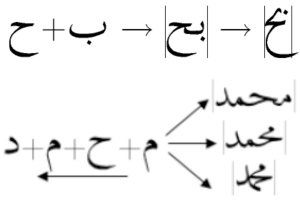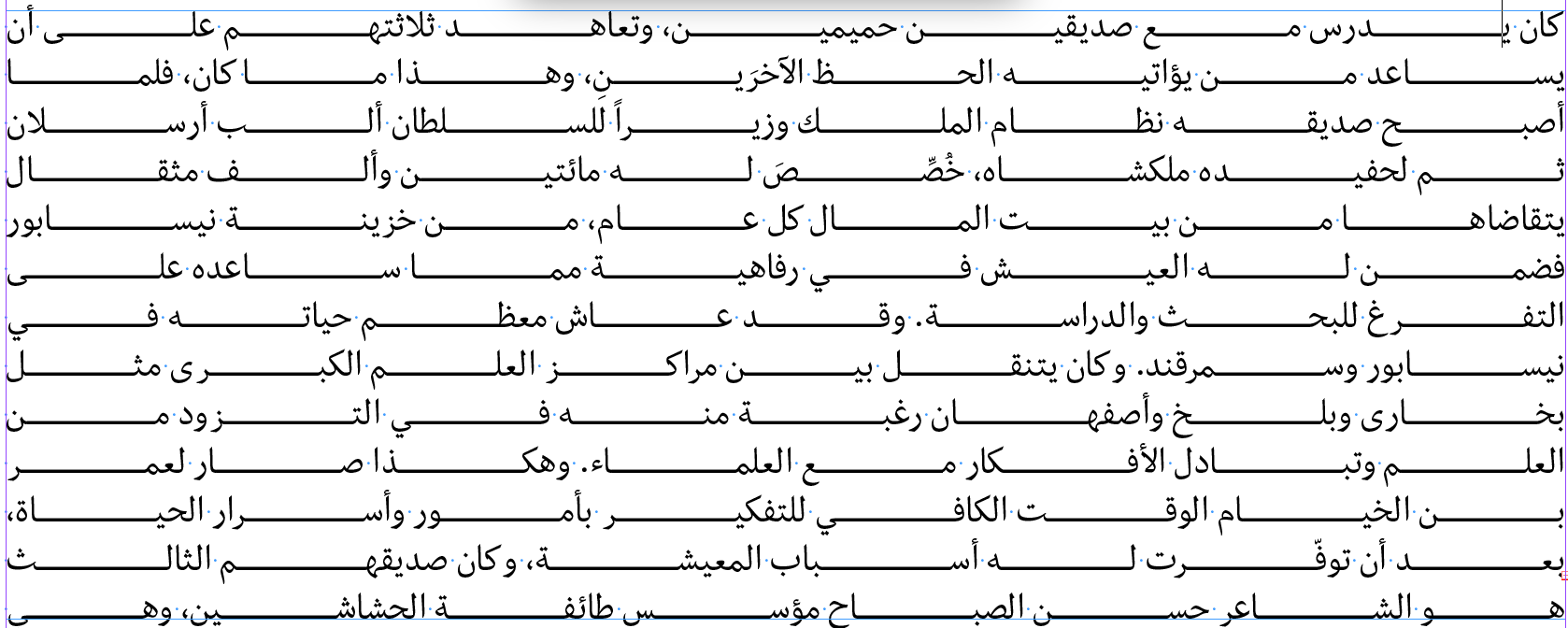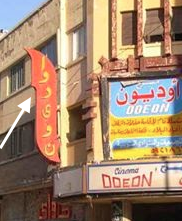Arabic Script Overview
Encoding
Arabic script is encoded in the Unicode standard semantically, meaning that every letter receives only a single Unicode character, no matter how many different contextual shapes it may exhibit.
Unicode also has a partial set of non-semantic encoded characters for the Arabic script, under blocks Arabic Presentation Forms-A and Arabic Presentation Forms-B, which are deprecated and should not be used in general interchange.
Characters
Appendix lists characters used for the Arabic and Persian languages. Characters used for these languages include letters and diacritics, three sets of digits (usage depending on the region), punctuation (some common and some specific to the script), symbols, and Unicode formatting characters.
The majority of these characters are common among different languages. There are three different sets of digits used by different languages. Most of the alphabetical characters are used by all the languages using Arabic scripts, but there are exceptions, such as the Arabic letter yeh being represented with two different characters, U+064A ARABIC LETTER YEH (ي) and U+06CC ARABIC LETTER FARSI YEH (ی). These differences among the character sets of each language are marked in the appendix tables.
Control characters are used to produce the correct spelling of the words or to ensure correct combination with left-to-right content. Consequently, they should be preserved when storing and displaying texts.
Direction
Arabic script is written from right to left. Numbers, even Arabic numbers, are written from left to right, as is text in a script that is normally left-to-right.
When the main script is Arabic, the layout and structure of pages and documents are also set from right to left.
Unicode Bidirectional Algorithm (or bidi algorithm, for short) [[!BIDI]] details an algorithm for rendering right-to-left text and covers a myriad of situations in mixing different kinds of characters. A simpler explanation of the basics of the algorithm exists in the W3C article Unicode Bidirectional Algorithm basics. [[UBA-BASICS]] You can refer to these documents for more information about Unicode’s bidirectional algorithm.
A brief overview of the bidirectional algorithm follows, because the direction is an essential part of how Arabic script is used.
The characters of a text are digitally stored and transferred in the same order that they are typed by a user. This is the order in which the text is read and pronounced by people and held in memory by software applications, as shown in for a sample text.
But the order used when displaying text is different. The purpose of the bidi algorithm is to find display positions for the characters of a text. These positions are solely used for displaying texts. shows the same sample text when prepared for display with the bidi algorithm.
An initial step of the process involves determining each paragraph’s base direction: whether the paragraph is left-to-right or right-to-left. The base direction is either explicitly set by the author, inherited from the page, or (typically for user-generated content) detected based on the content of the paragraph. The base direction has two important uses later in the process.
The next step is to split the text into directional runs. Each directional run is a sequence of characters with the same direction.
Inside each run, all the characters follow the same order. The runs themselves are ordered for visual representation from left to right or from right to left, depending on the base direction of the paragraph. demonstrates an example of this. This is the first effect of the base direction.
Unicode has a bidi class (or bidi type) property defined for each character that is used to determine the direction of each character. All the Arabic letters are marked as right-to-left characters, while Latin characters have the left-to-right category.
Some characters, mostly punctuations, are neutral. The direction of these characters is derived from their surrounding characters. If a neutral character is surrounded by characters of the same direction (e.g. an space surrounded by Arabic letters), it gets the direction of its neighbors. Otherwise (e.g. a space between an Arabic and a Latin, or a neutral character appearing at the start or the end of a paragraph), the neutral character gets its direction from the paragraph’s base direction. This is another effect of the base direction in the bidi algorithm.
The above explanation of the bidi algorithm is highly simplified, to convey only the essentials of how Arabic text is transformed for rendering. The actual algorithm deals with many more character types and edge cases. Please refer to Unicode Bidirectional Algorithm basics [[UBA-BASICS]] for more information or Unicode Bidirectional Algorithm [[!BIDI]] for the official detailed documentation.
Joining
Arabic script is a cursive writing system; i.e, letters can join to their neighboring letters. Besides the core behavior of the script, there are some details on how content is encoded in Unicode, and some rules around joining behavior when rendering special cases.
Joining Forms
Every Arabic letter has one, two, or four different joining forms, which allow the letter to join to its neighbors, if applicable. These four forms are:
- Isolated form, used when the letter does not join to any of the surrounding letters;
- Initial form, used when the letter is joining only to its next (left-hand side) letter;
- Medial form, used when the letter is joining on both sides, and
- Final form, used when the letter is joined only to its previous (right-hand side) letter.
shows samples of all four joining forms for U+0645 ARABIC LETTER MEEM (م).
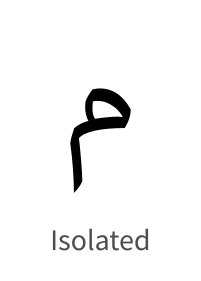

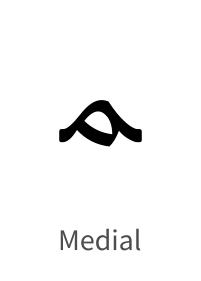
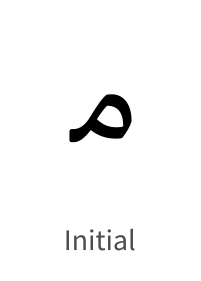
We define the following two groups of joining forms:
- Join-to-left forms: either Initial form or Medial form of a letter, which joins to the left-hand side (next) letter. Other forms are called non-join-to-left.
- Join-to-right forms: either Medial form or Final form of a letter, which joins to the right-hand side (previous) letter. Other forms are called non-join-to-right.
Joining Categories
There are different categories of letters based on their joining behavior:
- Dual-joining letters: can join from both sides, like the letter in , and has all the four shapes mentioned above.
- Right-joining letters: can only join to their previous (right-hand side) letter, and therefore, only have isolated and final shapes. shows samples of both forms for U+0631 ARABIC LETTER REH (ر).
- Non-joining letters: cannot join to any surrounding letter, and therefore can only take the isolated form. shows a sample of U+0621 ARABIC LETTER HAMZAH (ء) in its only possible form.
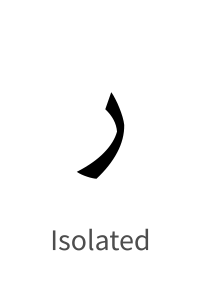

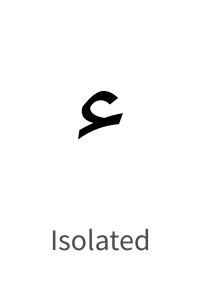
Joining Rules
There are core rules on how letters join to each other in the Arabic script, which stay valid regardless of the medium (hand-writing, typewriter, movable-type, digital, etc):
- Letters of each word join together whenever possible, implicitly.
- In some languages, like Persian and Urdu, there are words—mostly, but not limited to, compound words—that require explicit breaks in the joining of letters, although joining would otherwise be possible.
- In certain cases, a letter can be in a join-to-left form without actually connecting to anything on the left, whether there’s any letter or not. This is often seen in list counters, abbreviations, and other cases where letters do not have a word context, or are taken out of their original word context.
- In rare cases of words splitting where letters are joined, first letter of the second half will be in a join-to-right form without any previous letter. This behavior is limited to special cases like blanking specific letters of a word, line breaks in a paragraph, and word breaks across poetry verses. No standalone word can have any letters in join-to-right form without joining on the right-hand side.
demonstrates how letters join (per Joining Rule 1) to form a word.

Joining Control
Arabic letters are represented in their intended joining forms in hand-writing, typewriters, and old (deprecated) digital encodings of the script. In Unicode, letters are encoded semantically—meaning without any information about their joining form—and therefore there’s need for a mechanism for controlling of the joining behavior of the letters.
In Unicode, by default, neighbor Arabic letters join together if and only if both letters are able to join towards the other.
Disjoining Enforcement
As noted in Joining Rule 2, sometimes two Arabic letters sit next to each other (in one word) which would normally join together, but should not. In Unicode, for such a case, a special character should be used to enforce disjoining of these letters. This character is called U+200C ZERO WIDTH NON-JOINER, or ZWNJ for short.
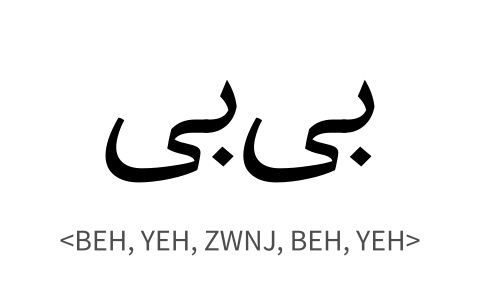
Joining Enforcement
Similarly, as noted in Joining Rule 4, sometimes an Arabic letter needs to take a joining form when it would not happen normally. For example, some abbreviation methods use Initial Form of letters, when possible, for every letter in the abbreviation. Again, in Unicode, a special character should be used to enforce joining on this letter. This character is called U+200D ZERO WIDTH JOINER, or ZWJ for short.
Besides ZWJ, there’s another special Unicode character, U+0640 ARABIC TATWEEL, which enforces joining behavior (join causing) on letters next to it. But, in contrast to ZWJ, TATWEEL has a glyph shape, looking like a hyphen and usually as wide as the SPACE glyph, which connects to the letters on the main joining line (a.k.a. base-line). So, using TATWEEL would give a similar Joining Enforcement behavior, but has a side effect of wider length for the letter, which is not always desired. That’s why it’s highly recommended to only use ZWJ for joining control.

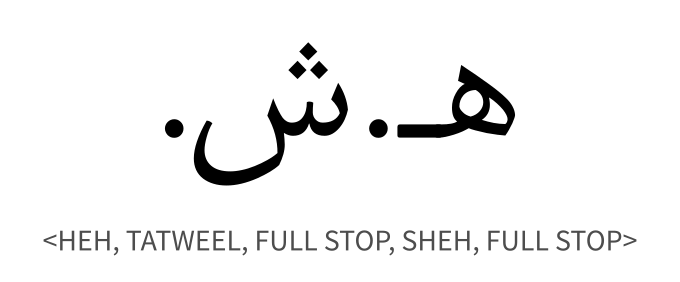
Joining-Disjoining Enforcement
Two enforcement methods mentioned above can be combined together to form a Joining-Disjoining Enforcement method, that enables Joining Rule 3 for cases when there’s a dual-joining/right-joining letter after a join-to-left letter, which should not be joined to its previous letter.
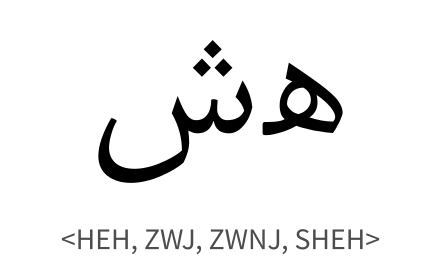
Context-Based Joining
Joining Control is not only managed by the content, but sometimes happens by the word context. For example, a word may be broken between two joined letters because of line break, meaning the content is not changed and only the joining form of letters should be maintained across the break.
Joining Segments
A sequence of letters that join together are called a Joining Segment. Regardless of language, joining segments have no direct relationship to syllables.
Two types of joining segments exist: closed and open.
Closed Joining Segments
Joining Segments usually have a closed form, meaning that they start in a non-join-to-right form and end in a non-join-to-left form. Closed joining segments are the result of segments either start and end with their normal behavior (Joining Rule 1), or by disjoining enforcement (Joining Rule 2).
There are two possible types of closed segments:
- Single-Letter Closed Segment, which contains only one letter that is in its Isolated form.
- Multi-Letter Closed Segment, which contains more than one letter, starting with an Initial form, zero or more Medial forms, and ending with a Final form.
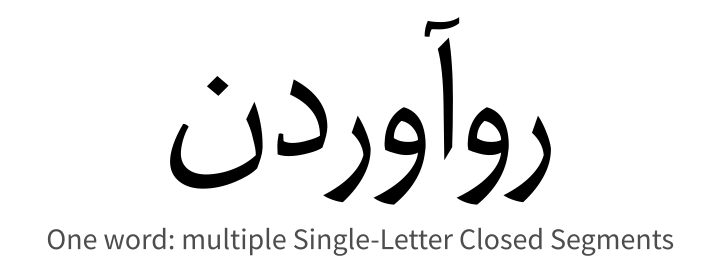

Open Joining Segments
Under the certain cases, as noted in Joining Rules 3 and 4, joining segments can start with a join-to-right form, or end with a join-to-left form, or both.
There are three possible types of these segments:
- Open-On-Left Segment, which contains one or more Dual-Joining letters, starting with an Initial form and continuing with zero or more Medial forms.
- Open-On-Right Segment, which starts with zero or more Medial Form letters, and ends with a Final Form letter.
- Open-On-Both-Sides Segment, which contains one or more Dual-Joining letters, all in their Medial Form.
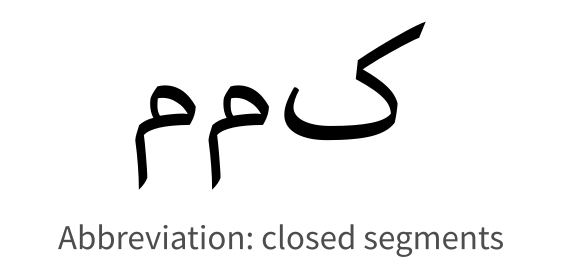
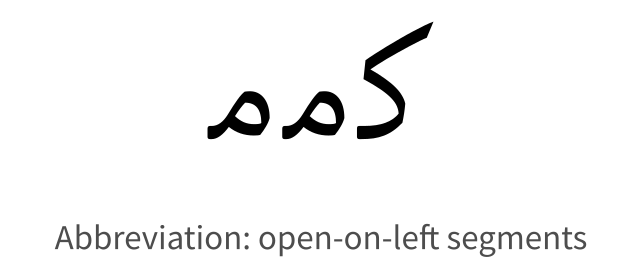
Non-Joining Characters
Arabic Letters, two Joining Control Characters (ZWNJ and ZWJ), and TATWEEL are the only characters used in the Arabic writing system with joining behavior.
Arabic diacritics, other Unicode non-spacing marks, and most Unicode format control characters are considered transparent in joining behavior.
All other Unicode characters in Arabic script (as well as Latin and many other major scripts) are non-joining and do not take any joining forms other than Isolated.
For more the details on Arabic Cursive Joining algorithm, please refer to chapter Middle East-I — Modern and Liturgical Scripts of The Unicode Standard. [[!UNICODE]]
Ligatures
Almost all the writing styles of Arabic script use a special shape when letters lam and alef are joined. Most Arabic fonts include mandatory ligatures for this combination. Ignoring this ligature, as shown in , leads to wrong rendering of text.
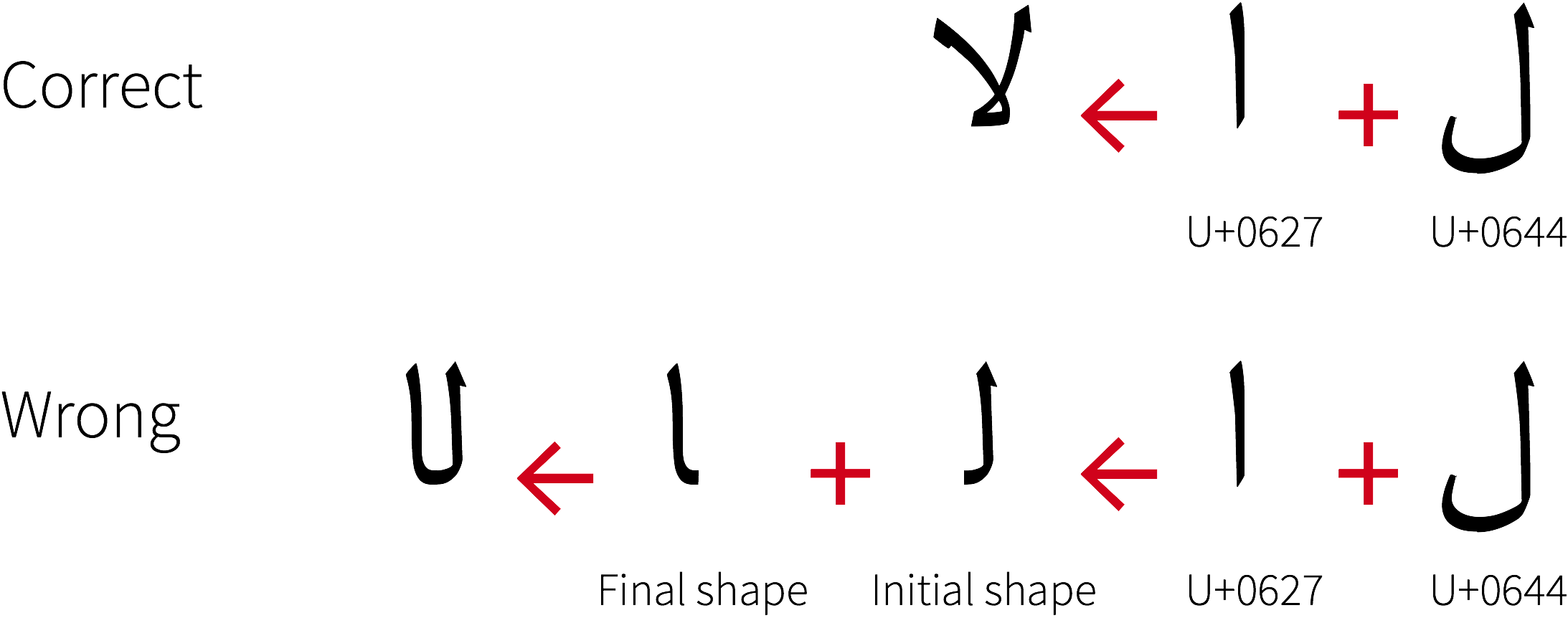
This shape is not limited to the combination of U+0644 ARABIC LETTER LAM (ل) with U+0627 ARABIC LETTER ALEF (ا). Variations of letter alef such as U+0622 ARABIC LETTER ALEF WITH MADDA ABOVE (آ) and U+0623 ARABIC LETTER ALEF WITH HAMZA ABOVE (أ) and also variations of letter lam follow the same rules as well. Combination with diacritics does not affect these ligatures. Each of these ligatures also provides a special shape for joining from its right side (to the preceding letter).
Diacritics
More than one diacritics can appear after a single character subsequently and all of them should be applied over the same character. Font files usually define special shapes or positioning for combination of diacritics. These extra information should be applied in rendering texts.
shows an example, where, according to this font’s specification, combining U+0651 ARABIC SHADDA and U+0650 ARABIC KASRA changes their positions. Various font files may require different transformations.
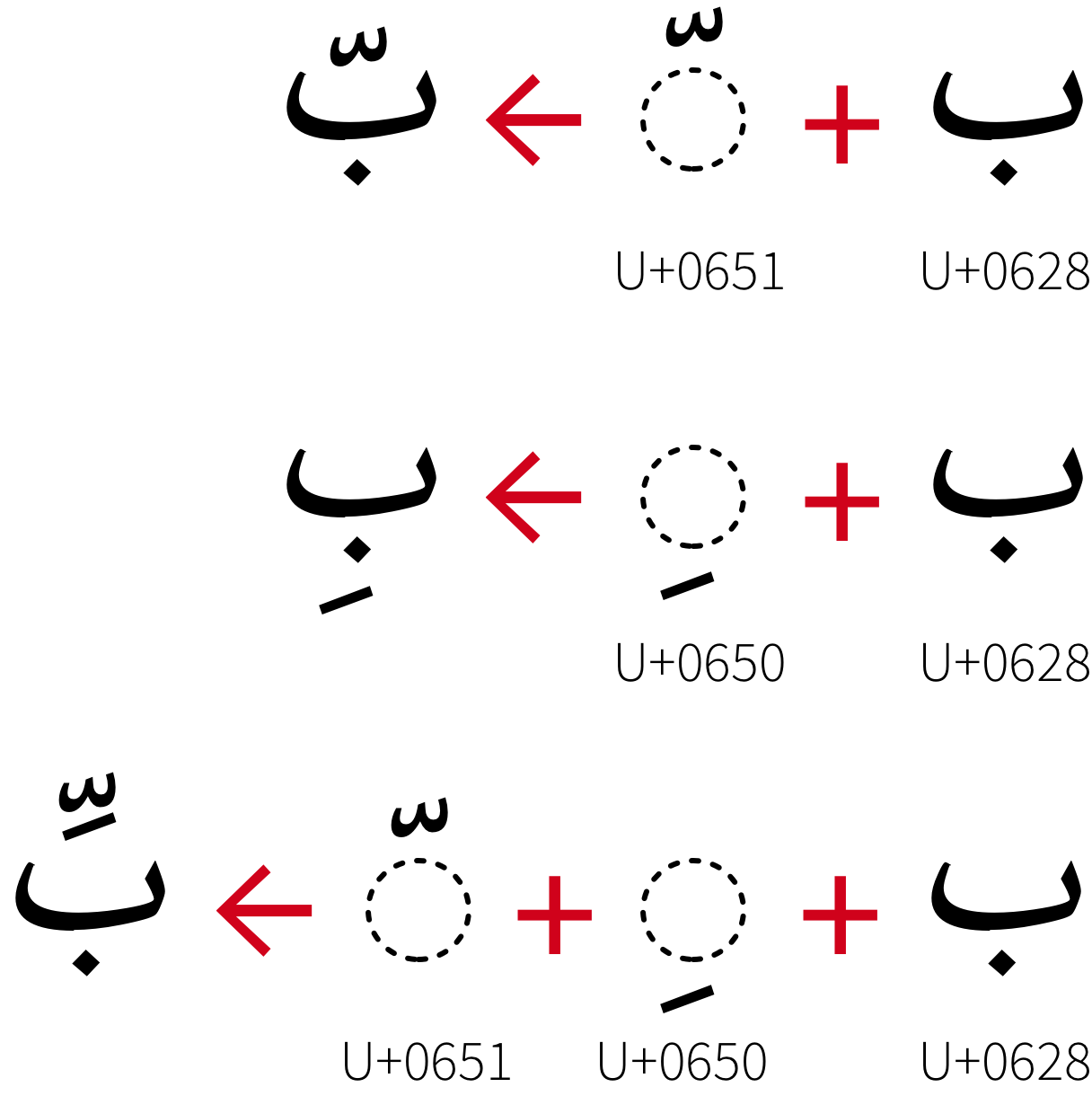
Font and Typographical considerations
Arabic Style and Calligraphy
Arabic styling and writing has its origins in Islamic art and civilization, and was widely used to decorate mosques and palaces, as well as to create beautiful manuscripts and books, and especially to copy the Korʼan. Arabic script is cursive, making it viable to support different geometric shapes overlapping and composition. Words can be written in a very condensed form as well as stretched into elongated shapes, and the scribes and artists of Islam labored with passion to take advantage of all these possibilities.
From the beginning of Arabic calligraphy, two tendencies or two types of styles can be seen emerging: writing for the decoration of mosques and sculptures, which was complex and highly decorative, and writing styles reserved for writing the Korʼan, which were easier to use and more readable.
Writing styles then evolved under the influences of cultural diversity, leading to regional calligraphic schools and styles (Kufi in Iraq, Farsi and Taʻlīq in Persia, or Diwani in Turkey). Additional differences arose depending on the purpose of writing, such as the copying and dissemination of the Korʼan.
In general we group under the generic term Naskh (copy/inscription) the scripts which are meant for reading at smaller sizes and are suitable for books and texts to be read, e.g. the Korʼan, and as Kufic the highly stylized font styles used for ornamentation and more styled writings. Nevertheless, the rich evolution of the Arabic script led to the distinctive enumeration of a number of additional named styles.
Similarly, two other generic terms are used to classify styles : Mabsut (wa Mustaqīm) is a form of style that is elongated and straight angled, [which dominated the copies of Korʼan in eighth and ninth centuries], and Muqawwar (wa Mudawwar) is a form of style that is curved and rounded.
Different Writing Styles
Basics and principles of Arabic writing were defined by Ibn Moqlah (886-940 Higra), who defined six styles of writing: Kufi, Thuluth, Naskh, Ruqʻa, Taʻlīq and Diwani.
- Kufi (كوفي)
-
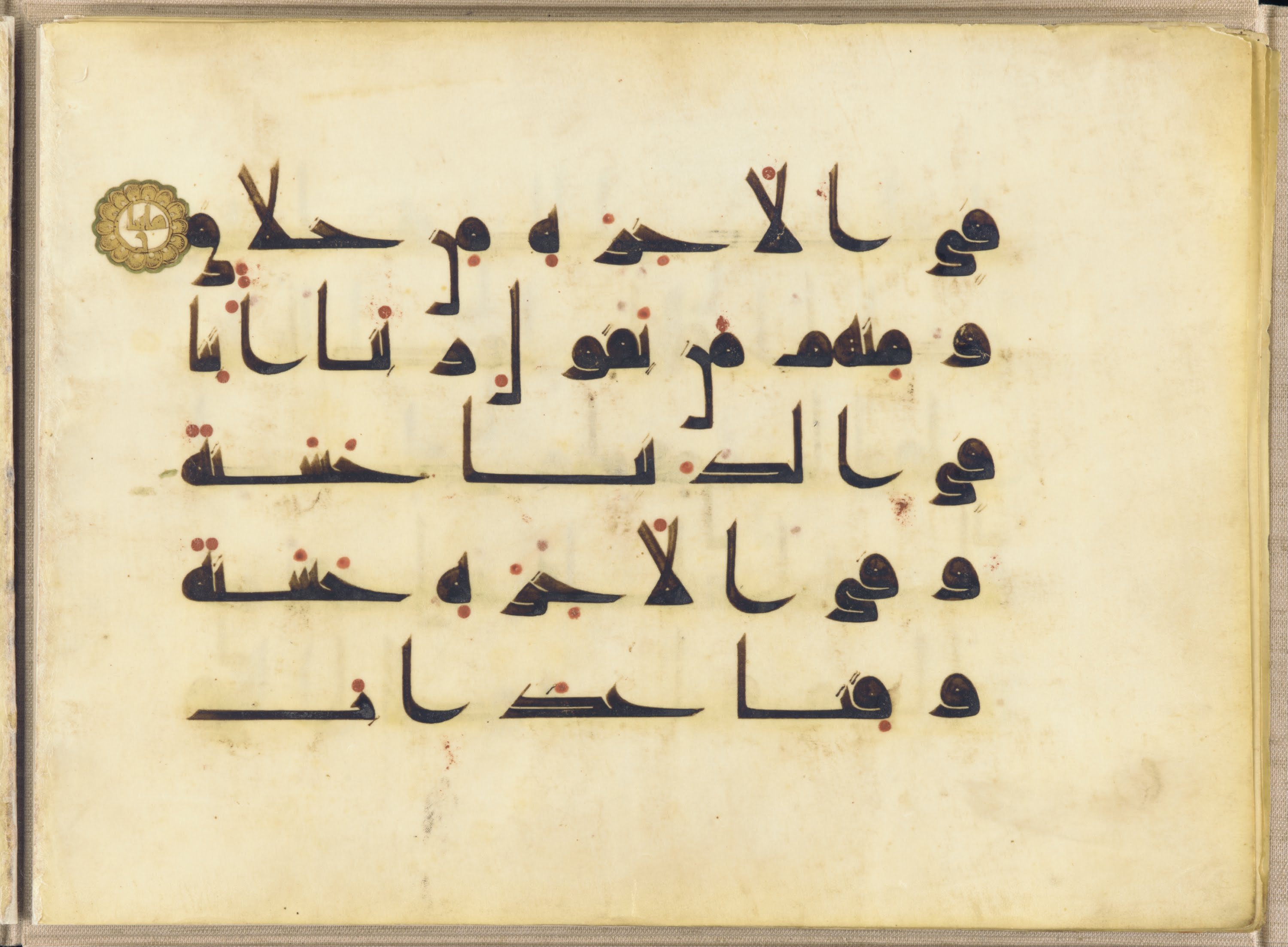
Kufi example [Source]. One of the oldest and best known Arabic scripts. It is characterized by its decorative and pronounced geometric forms, well adapted for architectural designs. The style grew with the beginning of Islam to satisfy a need for Muslims to codify the Korʼan.
- Thuluth (ثلث)
-
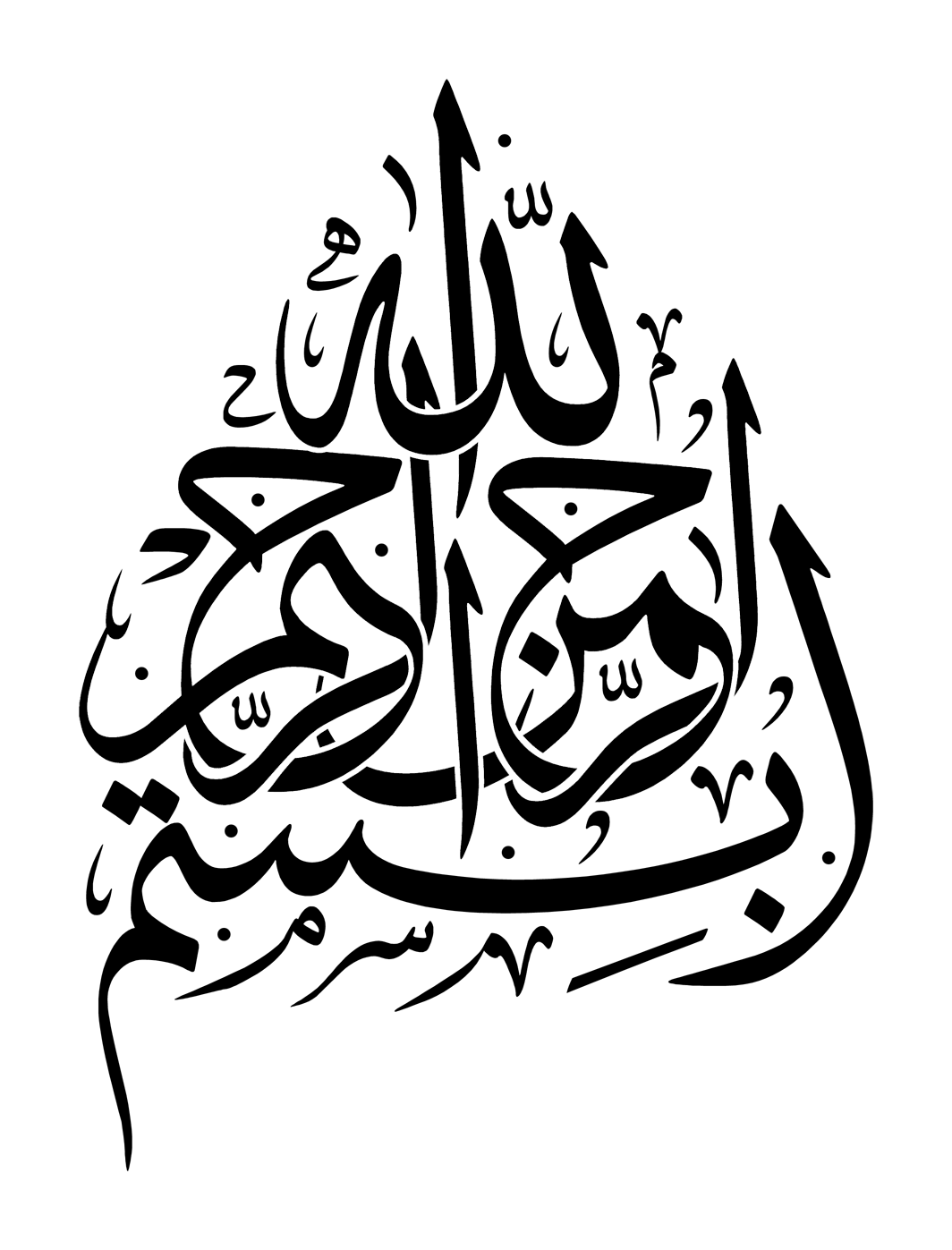
Thuluth example [Source]. (The third.) Recognizable by the fact that the letters and words are highly interleaved in its complex form. May be the most difficult style to write (requiring a significant amount of skill), both in terms of its letters and in terms of its structure and composition.
- Naskh (نسخ)
-
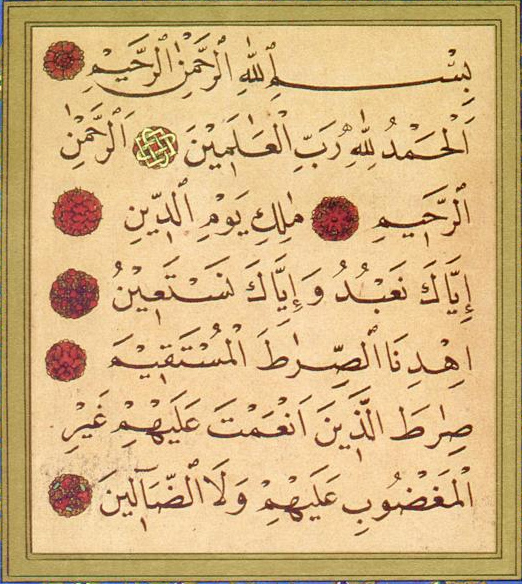
Nask example [Source]. One of the clearest styles of all, with clearly distinguished letters which facilitate reading and pronunciation. Can be written at small sizes (traditionally using pens made of reeds and ink), which suits the production of longer texts used for boards and books intended for the general population, especially the Korʼan.
- Ruqʻa (رقعة)
-
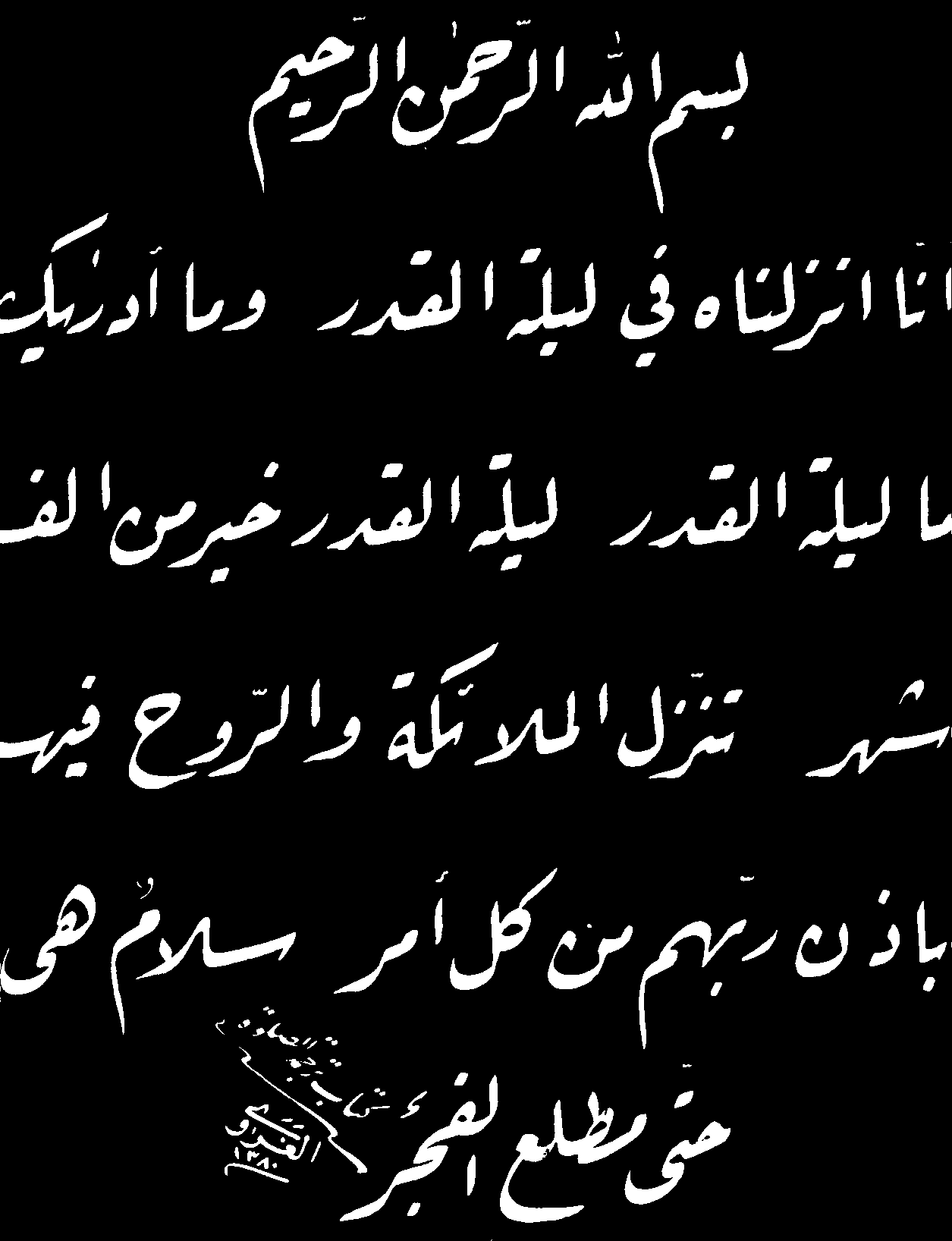
Ruqʻa example [Source]. A handwritten style still commonly used in Arabic countries, and recognisable by its bold-like letters written above the writing line. Designed to be used for education, for everyday writing and adopted in the offices (Diwan) of the Ottoman Empire. One of it's feature is that calligraphers have kept it and did not derived variations from it.
- Taʻlīq (تعليق)
-
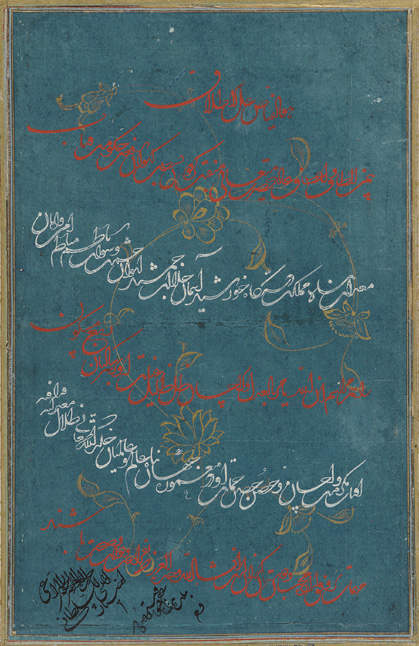
Taʻlīq example [Source]. Taʻlīq (hanging) is a beautiful script characterized by the precision and stretch of its letters, its clarity, and its lack of complexity. Designed for Persian language, until replaced by Nastaʻlīq.
- Diwani (ديواني)
-
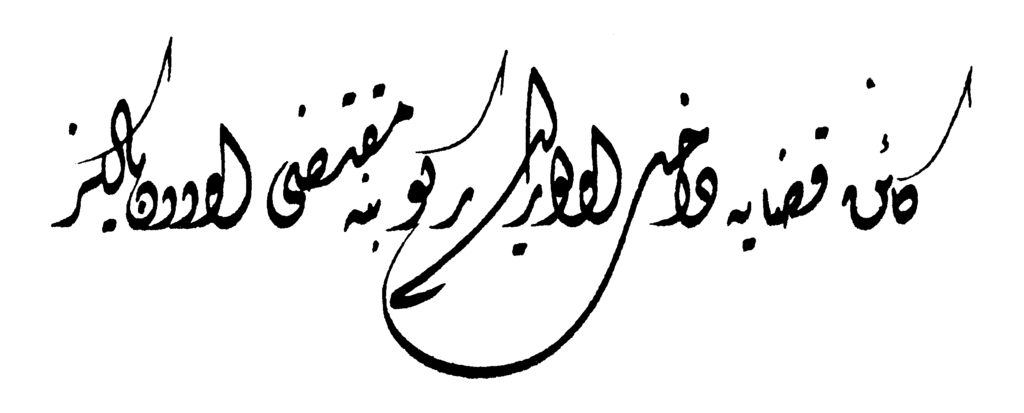
Diwani example [Source]. Used by the Ottman court (Diwan) to write official documents. Some variations of it are still in use today (e.g. hand written documents by some religious officials).
We can add other font styles to this list, such as the following :
- Nastaʻlīq (نستعلیق)
-
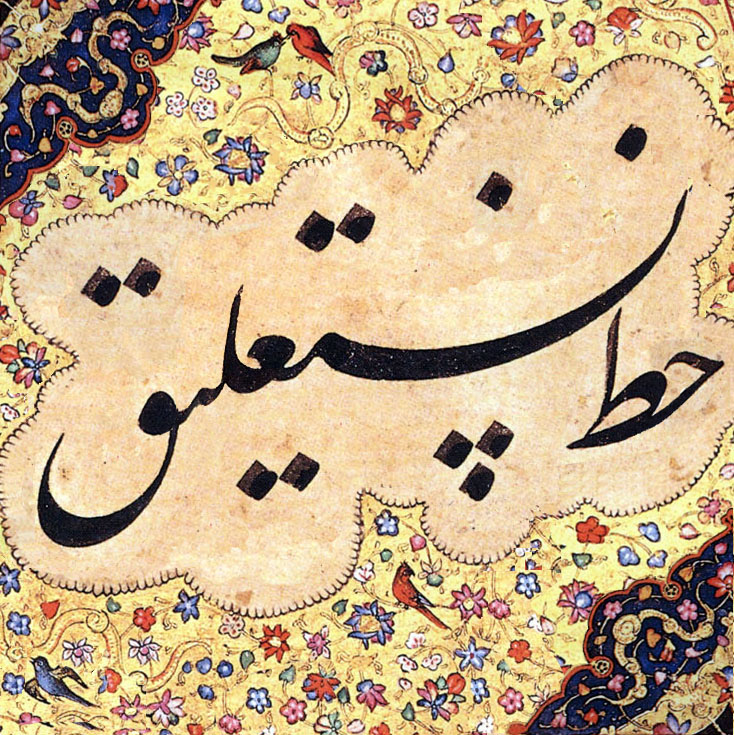
Nastaʻlīq example [Source]. Persian version of Taʻlīq, derived from Naskh and Taʻlīq and developed in the 8th and 9th centuries. It is like a Taʻlīq but easier to write and read. Shekasteh Nastaʻlīq (literally means "broken Nastaʻlīq") is also another derivation of those two, developed in the 15th century.
- Maghribi (مغربي)
-
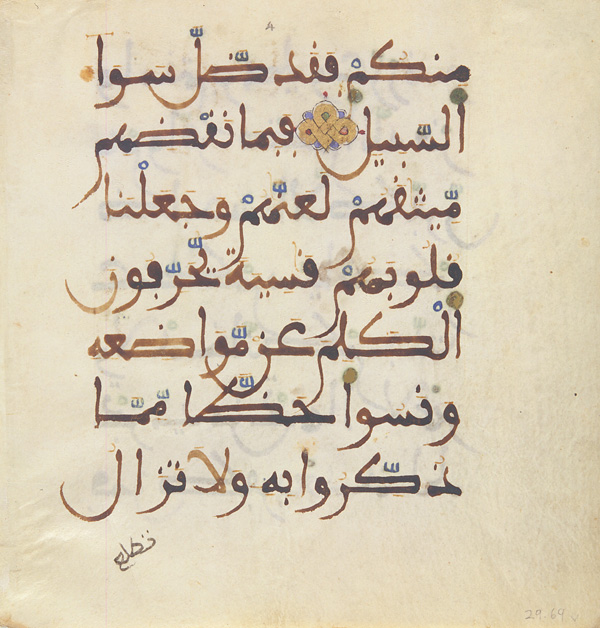
Maghribi example [Source]. Used in the past in the western islamic world (Andalusia), and still now in North Africa. Used for writing the Korʼan as well as other scientific, legal and religious manuscripts. Rabat, a mabsut version of it, is widely used in some official printings in Morocco.
Arabic Script and Typography
Arabic script has some characteristics that are challenging for typographers and font designers. Examples bellow show some characteristics worth to be considered carefully. How could typography, which came late to the Arabic world, then follow the tradition of the many authors and artists who manually shaped the Arabic writing over decades? even in it's simplest Naskh style?
Multi-level baselines
Letters may join through a finely inclined line

or two, square-ended lines

Multilevel baselines don't occur in all fonts. The above examples use the Arabic Typesetting font. Compare those examples to more typical fonts:

Multi-context joining
Rendering of letters depends not only on their place in the word (initial, medial, final) but also on their neighboring letters, i.e. the letter they join with. Each letter has a different appearance in each combination.

Fonts don't always comply with or respect this kind of tuning. To do so, fonts need many glyphs in order to adapt to each context. In more modern typefaces some of these connections are implemented by ligatures, but ligatures can't capture or cover all joining behavior.
In the two left most words, the initial noon differs in that one raises a kind of
stroke. This property of raising a stroke is common for a number of letters (beh, teh,
noon, theh) which are taller than their connected letters in order to be distinguished in
some contexts, such as  vs.
vs.  , or to resolve ambiguity. See also the section about teeth letters
below.
, or to resolve ambiguity. See also the section about teeth letters
below.
Words as groups of letters
A word shape is not (only) a "horizontal" connections of letters, but of groups of letters (syntagmes).
Example two words in some nice Naskh font.

|
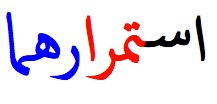
|
To compare with the same words in more usual font:

|

|
Group combinations cannot be covered by general or usual ligatures.
Vertical joining
Groups of letters may also "join" vertically (top down) instead of right to left. And not all fonts permit this.

|
vs. | 
|
| Joining happens almost vertical | Joining happens horizontal |
Once again, some fonts try standard ligatures, but this is not ligature. This is rather (good) writing practice/style.
One should note that all this characteristics has not only an aesthetic side, but also play a role in justification. It is at the discretion of (hand writing) authors to chose the best kind of joining to suit the desired line width. Should then be a general rule on that. But to achieve such justification would require sophisticated algorithms.
The so called teeth letters.
Letters having uniform medial shape, align in a kind of teeth.

Even in the teeth context letter shape may vary. It's not the same letters (in red) which raise the stroke in the two figures.
Fonts
Arabic script counts 26 letters, and mostly 19 basic shapes. Since letters change according to their position in the word, Arabic set of glyph may range to more than one hundred shapes. If one count possible ligatures, and different combination of joining forms (see above), the number of glyph can increase further. Not sure that typeface design can accommodate all needs, even though some present typefaces can run hundred of shapes.
Early typefaces, some still in use today, were designed with some facilities. Designer of those differs in their simplification hypothesis. For example, one of the first approach is to use "type writer style", that is a same glyph for different positions in a word. This is the case for initial and medial shape for most of the letters (example here). It is generally the browser default font for Arabic script. A more unifying approach is the use of a single and detached glyph for each letter without joining (todo example here). Other approach were used resulting in more or less visually practical fonts.
Nowadays, there is a large choice of fonts, and one can choose the font that best suits to one's typographical desire. However, one may also wishes to take into account some non typographical considerations like: (TBD later on)
- Accessibility (readability and visibility) ...
- The kind of device with small screen (for example, larger loop and teeth height, small descenders etc...), although fonts actually appear better on smartphones
- Font style for titles and banners and alike (small number of words), may differ from the style for content text (long text).
- Shapes and proportions (the size issue) in mixed texts
- Some fonts might give another opportunity for line justification than the one based on word spacing (See section 4.2.4 Ligatures).
- etc...
